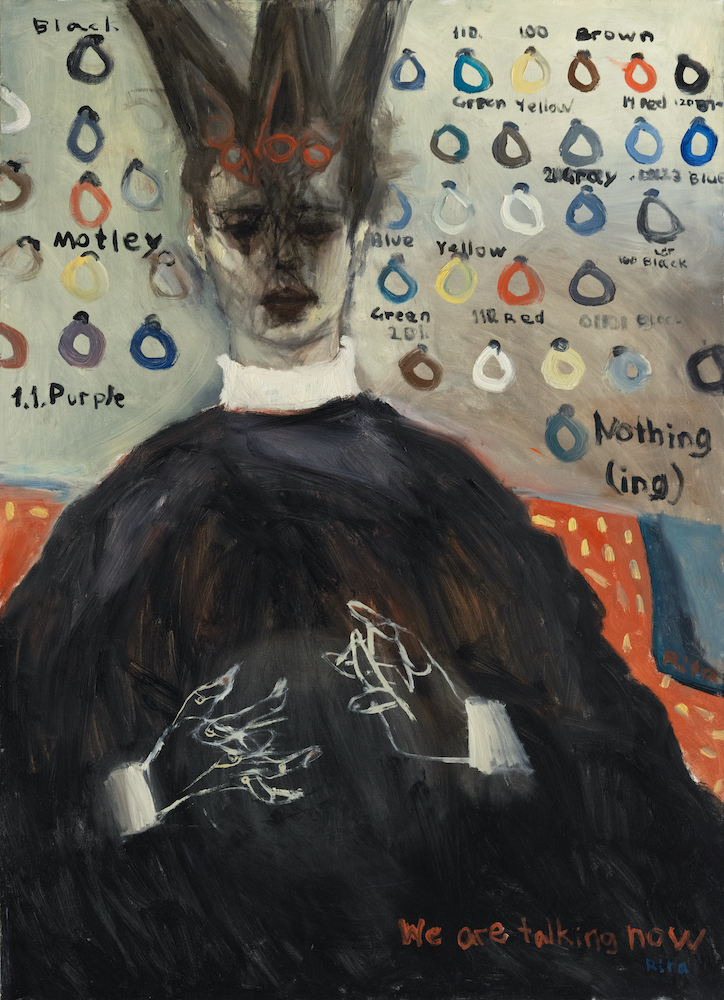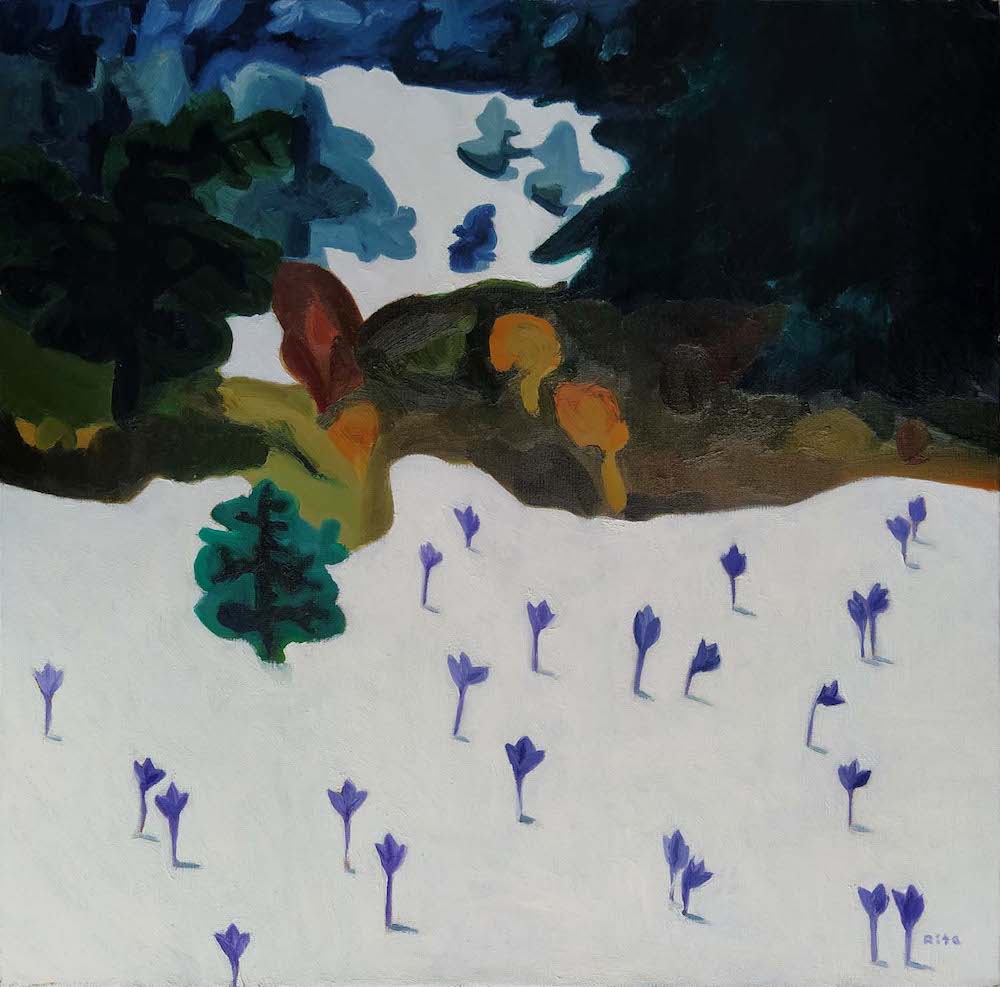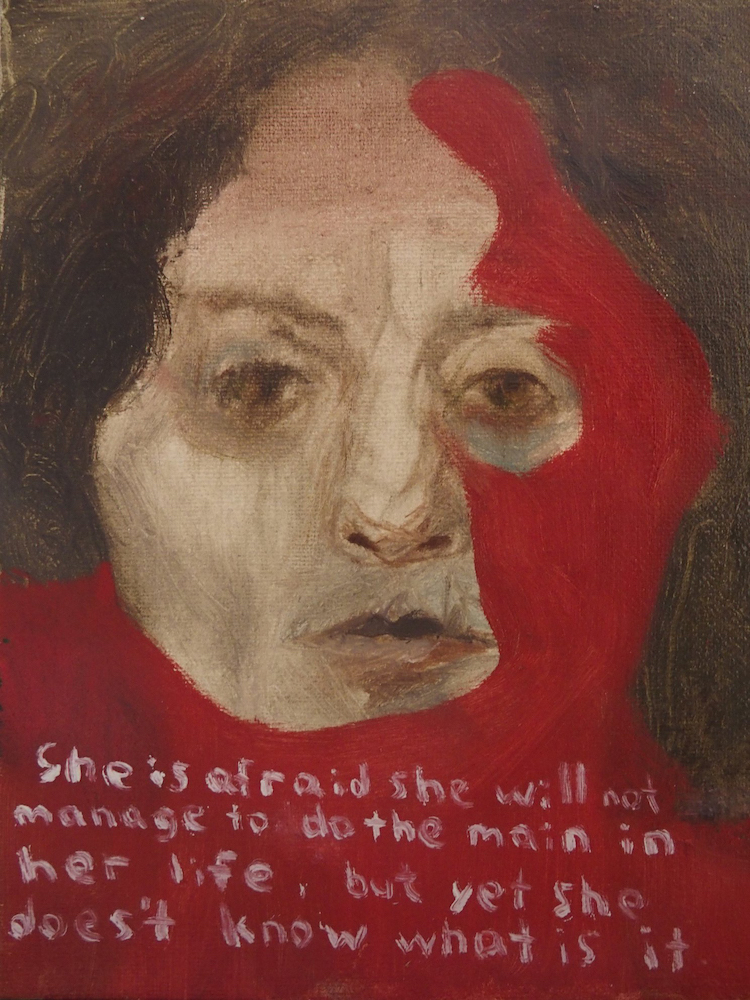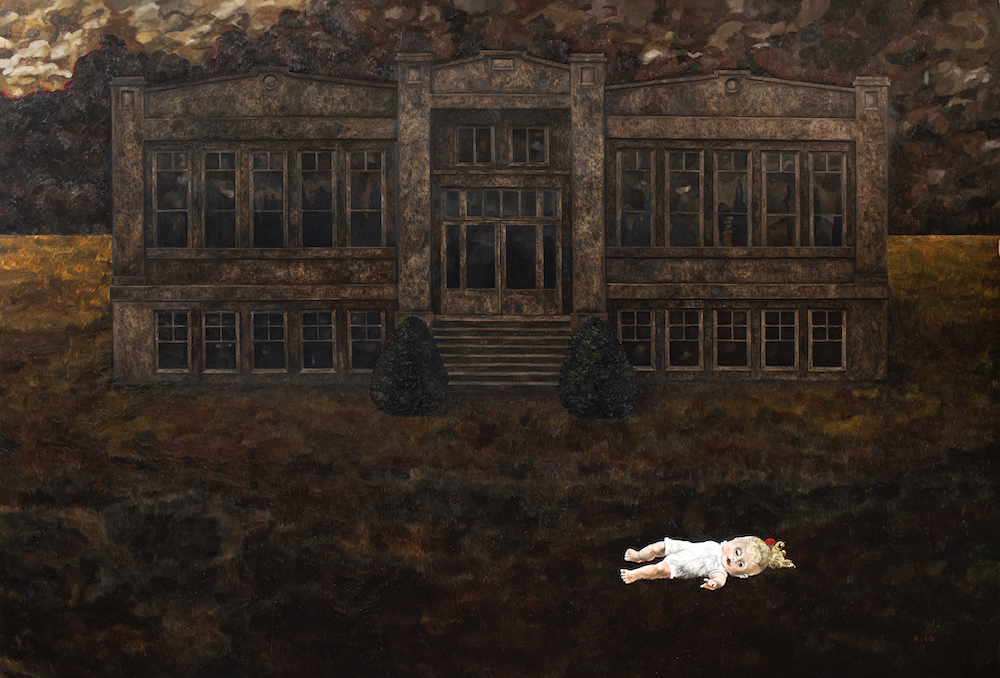
Feel free to add tags, names, dates or anything you are looking for
_(1).jpeg)
_(1).jpeg)
Since the beginning of the 20th century, when fine art declared a battle against physical representations of the material world and the figurative image “vanished" from the art world for almost half a century, the line of artistic development was decisively shifted. In the 1960s, material origins returned auspiciously to art, but nonetheless having acquired new features or, to put it literally: materiality, the new figurative style or novelty formation and its widespread conceptualization. The image could no longer regain its former glory, since the transformation of the easel picture, the evolution of its typological structure and the new media that were conceived in the general direction of visual art, questioned the non-alternativeness of painting and significantly diminished the value of the painting itself, as well as the role of the image in it. It can be said that since that time, the image in painting has been undergoing a crisis. I think an extraordinary, honest and powerful image is one of the main challenges of painting in our time. One of the finest examples of the above mentioned in contemporary Georgian art is Rita Khachaturian’s (რიტა ხაჩატურიანი) painting.
.jpg)
Rita Khachaturian. Cotton. 200x250. Oil on canvas.
In 2007, Rita Khachaturian graduated from the Faculty of Easel Graphics at the Tbilisi State Academy of Arts, and has been leading an extremely active creative life ever since: she has constantly taken part in group exhibitions and art fairs both in Georgia and abroad; she has also held a number of solo exhibitions in Tbilisi – both in private galleries and in institutional art spaces (Tbilisi History Museum “Karvasla”, the State Museum of Literature, and the National Gallery of Georgia). At her exhibitions, Rita usually displays a series of works linked around a specific theme, which is the culmination of several years of intensive creative work. The nature of the artist is to explore deep existential themes within the framework of one series of easel paintings, sculptures, or with different media of contemporary art, “researching” topics that are important and actual for her: the morphology of a spiritual being with a human body, fear as a manifestation of human nature, and the fragile border between life and death, among others.

Rita Khachaturian. Autoportrait. 140x100. Oil on canvas. 2017. Photo by Gia Chkhatarashvili.

In 2017, works that Rita produced through 2014-2016 were combined into one of her first large series. The author titled the series Morphology, thus openly stating that the main priority was research into primary conditions and visual patterns and their articulation with the principal forms of the body. It was as if the artist had rejected all of her own figurative paintings, erased the knowledge and experience she had gained, and rediscovered the material world – above all the human body – and began studying it much more thoroughly from scratch. Rita analyzes the structure of the human body – its inner structure, and strives to understand its “meta-anatomical” mystery. In addition, Morphology is also defined as “an aspect of grammar that studies changes in word forms associated with the respective changes in meaning.” As such, Rita is not interested in the existing, already established and completed form, but rather the process of formation itself (i.e. construction, destruction, as well as deconstruction). The artist is interested in the interrelationship between forms that are still in the amorphous stage, the potentially existent shaping forces within them that reveal themselves through development and formation, and the still unsculpted bodies that will display their identity through their gender in front of our eyes. That is why the eroticism of the figures of the Morphology series is only at the “stage of conception” – it is still a part of the physiology of the body, and not yet a constituent component of the complex mental structure of man. (In this regard, it is interesting to observe the close-up of a head of garlic included in the series, which is a kind of authorial version of plant eroticism well-known in 20th century art – e.g., Georgia O'Keefe. With this kind of visual association, Rita Khachaturian indicates the “unconscious” existence of a living organism’s eroticism in general, detached from the human body, independent from it). Accordingly, with this series Rita illustrates the transformational stage of a spiritual being that has a human body, but for which the elements of personality and consciousness are still unknown; the artist explores the formation of the body, so to speak, the “collective unconsciousness”.

After exploring the human body, Rita Khachaturian completely engaged herself in the mental sphere and began researching one of the most basic psycho-emotional phenomena - fear; as the artist states, she studied the anatomy of fear (again the term denoting body structure!), and at the same time she analyzed the mental structure of man. Rita portrays all different levels of fear in the world: she does not even overlook the fear of being a silkworm in a chrysalis facing the completely new and unknown future; the fear of the pain of being born as a moth or not being born at all. However, the artist’s main focus is still a human being. Fear is the first feeling we experience at birth – the newborn's fear of a completely new form of existence is the first, most powerful emotion of a human entering this world. From that moment on, fear as a human existential anxiety manifests itself in various shapes or forms throughout our life. In addition, fear is an integral part of the life cycle, and as an instinct of self-preservation it is considered to be the driving force of humanity; one of the causes and instigators of human development. As a mechanism, from a phenomenological point of view, fear is common and universal; yet at the same time it is quite subjective, individual, and even intimate, since it is related to a human being’s personal experience, subject to the influence of various factors such as childhood traumas. Rita Khachaturian is interested in people's fears as an important element forming a complex psychological structure, as a manifestation of the similarities among people as well as the individuality of each person. Most importantly, with the intensity of her customary powerful iconography, Rita tries to visualize fear as an invisible psycho-somatic entity inhabiting the human psyche.
In 2018, the series Fear was exhibited in Tbilisi History Museum "Karvasla", and brought together about one hundred works created in different media (painting, sculpture, art object, installation). There were several thematic lines in the series, with the main ones having been painted on large canvases. The monumental androgynous images, which are presented in an emphatically representational three-figure composition on a black background, resemble both corporeal beings and idols. Three large and awkwardly plump identical figures that are deformed by obesity and have disturbingly small hands leave a gloomy impression. As much as the content or the subject matter of the work (which is based on a specific narrative) is unclear to the viewer, so real is the inner tension and alarm evoked by the restless look of the figures, who are holding a hammer and scissors in their hands. The viewer, who is seized by the fear of pain caused by physical injury, involuntarily leaves the position of observer and becomes a “victim”; a person obsessed with fear, thereby becoming involved in the process of learning about the mechanism/phenomenon of fear, and at the same time recognizing his or her own fear.

Rita Khachaturian. From the series Fear. 24x18. Oil on canvas. 2016
While researching the phenomenon of fear and interpreting it in the artistic form of pictorial language, Rita apparently recalled the first great master of this topic, Francisco Goya, and created one of her most effective works, which is distinguished by the intensity of its iconography. The clothing and hairstyle of the woman in the foreground clearly indicate her Spanish origin, while the male figures remind us of the characters in Goya's Black Paintings (in Spanish: Pinturas negras). The composition created by the dominance of white (the background), black (the men's clothing) and red (the woman's dress) pigments is exceptionally dramatic. The empty space of the white smoke seen in the background, space as a contingency of time, is experienced as a kind of topos perceived in timelessness. Viewers from this eternal timelessness, the faded ghost-like figures stare silently back at us. Their meticulously detailed, wide-open eyes appear unexpectedly and disturbingly realistic against the flat speckled painting of the background. Historical memory that goes back centuries and the eternal existential fear of mankind peer at us from these eyes. The four figures of men who are dressed in the same clothes and lined up behind the woman “sound” like the ominous prophecy of an ancient chorus, as if a warning from the distant historical past.
From the past, Rita moves into our reality and explores, or as she says “collects” the fears of our own contemporaries. In so doing, the artist has created a gallery of small-format portraits. The portraits that are created in a free, expressive manner on red backgrounds look more like posters and billboards, because each of them contains one sentence written in English describing what the fear of the person in the portrait is. Most of them are not so much a fear but a phobia - an unconscious, uncontrollable anxiety in a person or an obsessive idea that deprives people of rest and enjoyment, which is evident in the nervous and tense gazes of those persons portrayed. The artist tries to show us that fear is not something which occurs for no reason, something independent and detached from us; we are our fears, we create our own fears, and yet our fears also create us. For Rita, fear is a form of consciousness, which implies or at least requires its realization from us, rather than primitive methods of fighting as is commonly advocated. The artist looks with disbelief at the tradition of fighting fear, which she presents to us in the form of an installation at the exhibition entitled Prayer of Fear (which features a black-bladed knife, some coal, a lead pot, a glass full of water, etc.). Instead, Rita offers a better understanding and perception of fears or phobias, without which a person may be left alone with their fears, isolated from the environment and locked in, becoming like a silkworm in a chrysalis – a silkworm that will never feel the freedom and pleasure of being a moth.
Rita's 2019 series Batonebi (Masters/Lords) is a peculiar continuation of the theme of fear. This time the artist is interested in the forms of fighting against fear, which turn our relationship with death into a kind of carnival game. She “researches” people's fearful attitude towards “Lords”, perceiving them as supernatural beings, and the tradition of holding special rituals for them. However, beyond all this, the contemporary artist perceives the fear of a desperate person, which she attempts to neutralize with the anesthesia of ritual. As an iconic image of being defeated by the game of death, Rita creates imaginary portraits of “Lords”. The gloomy and conspiratorial look of the “Lords”, the general mystery of the works, and at the same time the festive mood of the parade portraits, all leave the viewer with a shocking feeling of “the majesty of death”. The expressiveness of the portraits is enhanced by vivid silhouettes of the figures that are represented in a flat speckled manner, and the texture of the fabric that is conveyed through painterly skill, organically connecting the system of contemporary art signs with the language of classical, realistic painting. Nonetheless, the contemporary character of the portraits created by Rita, the power and intensity of their artistic impact, is primarily due to the specific look of the unclothed parts of the body (mostly the face and hands). It is almost as if the artist has painted flayed bodies; when observing the portraits, we can clearly see the muscular tissue and vascular system under the skin of the body, which “disarms” not only the characters depicted, but also the viewers, since they are left without any protection against the environment. All of the above mentioned create inner tension and a kind of discomfort, especially when the body portrayed in the picture is not painted in natural flesh-colored tones, but in cold shades of gray. It should be mentioned that along with the aesthetic, such images are quite impressive and also terrifying to behold.
_2019._Oil_on_canvas._200x150cm._Photo_by_Gia_Chkhatarashvili..jpg)
Rita Khachaturian. From the Series Batonebi (Lords). 200x150. Oil on canvas. 2019. Photo by Gia Chkhatarashvili
Rita Khachaturian's recent 2022 series Serengeti, according to the author's concept, presents the “valley of life and death” … “the strengths and weaknesses of different life forms, their coexistence and participation in the process of life, where human and animal sensations are equalized.” Within the general theme of life and death, the concept is divided into numerous directions and addresses many urgent questions, including the danger of ecosystem collapse and the limited resources of the universe. Perhaps that is why this series, compared to all the others, stands out in its diversity; Rita presents us with a variety of thematic, stylistic and iconic visual images. The artist often refers to symbols or certain kinds of allusions (dead birds, a burnt wheat field, children with rabbit-eyed hoods but these are not visual signs borrowed from the dictionary of symbols familiar to us, they are rather images loaded by the artist with her own subtexts and meanings, which are completely autonomous within Rita’s oeuvre. We are given the opportunity/right to interpret; but the archetypal memory, in many cases, encodes the symbols in its own way. However, surrounded by such powerful images, the viewer ultimately succumbs to the artist's inclination.
_(1).jpeg)
Rita Khachaturian. From the series Serengeti. 200x250. Oil on canvas. 2022
The image of the mother holds a special place in this series, as the sustainer of life on earth and one of the primary figures of the continuous evolutionary chain; but even alongside this symbol of life and fertility, we see dead birds scattered on the ground. The themes of death, pain and journeying in a strange, desert environment also prevail in other paintings presented in the series. The valley of life seems to the artist to be a long and painful process of dying. In addition, for the artist, the main manifestation of the world's efficacy is its biodiversity of life, which does not eliminate at all the inevitable phenomenon of death. Human, animal or plant, as different forms of life, are equally meaningful for the universe, and the visible reality is a continuous cycle of life and death, in which all manifestations of life participate equally. Among all this, Rita perceives the mystery of a self-sufficient world, acting according to its own laws.
_(1).jpeg)
Rita Khachaturian. From the series Serengeti. 200x250. Oil on canvas. 2022

The unknown stories and images in Rita's monumental paintings are also full of mysteries. Zoomorphic women or anthropomorphic animals, figures or human-like creatures travelling in a strange, empty landscape; a gloomy building illuminated in the same environment, or a one-eyed doll out of a horror movie; a field bestrewn with dead birds, or mutilated animals and people; strange gardens depicted with outstanding pictorial skills, or cemeteries where the statues of angels appear more alive than the birds – all these leave the viewer with a feeling of terrifying mysteries and peculiar mysticism while faced with the unknown. Nevertheless, it should be mentioned that there is no spiritual-esoteric mysticism in Rita's works, since the artist who studies so deeply the morphology of the human body and its psycho-mental structure, as well as the laws of ecosystemic circular rotation and the visible world, practically denies any metaphysical aspect of human existence. Rita Khachaturian is primarily interested in the material aspect of the visible world and the mechanisms involved therein. Visualizing any content or concept and giving it a form is the main goal for an artist who focuses on iconic image paintings. Moreover, for Rita, as for any contemporary artist, it is not only important to give form to the content, but also to create an image with a strong emotional impact – an impressive icon-image that “will remain engraved” in the viewer's memory with all its intensity.
.jpeg)
Rita Khachaturian. From the series Serengeti. 200x300. Oil on canvas. 2022
In this regard, it is interesting that the images Rita produces are often on the border between the real and unreal, the normal and abnormal. In addition, Rita has created compositions (the series Room, 2016) where, in contrast to her usual clearly visible figures, she offers vaguely defined and slightly marked images implied in scattered spots. The eye cannot see, but only perceives the shape in general strokes; the spots are slowly settling, but still nothing is clearly visible. In the process of observing the work, viewers experience an inner tension: they are afraid because they “don’t trust” the artist, they know that the artist’s unbridled imagination and boldness will not spare them, and they will be shown what people have been blinded to for centuries. In this sense, Rita is a “ruthless” artist; she is a bold and uncompromising artist. Rita Khachaturian’s painting is not a comfort zone; it is a world of intense sensations and relentless visual imagery. As Johann Wolfgang von Goethe said: Anybody can see a thing, an object, the content is understood by the one who can add something to it, but the form remains an unsolved mystery. Those who want to look beyond the easy so as to grasp an object, to discover new contents in things and, most importantly, to share the mystery of form(shape) should not be afraid to dive boldly into Rita's art, from where the open-mouthed abyss of our subconsciousness, the archetypal memory and collective unconsciousness of humanity stare at us.